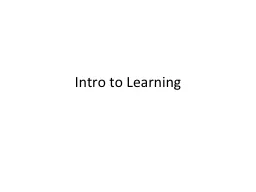

Introductions Name DepartmentProgram If research what are you working on Your favorite fruit How do you estimate P yx Types of Learning Supervised Learning Unsupervised Learning Semisupervised Learning ID: 389650
Download Presentation The PPT/PDF document "Intro to Learning" is the property of its rightful owner. Permission is granted to download and print the materials on this web site for personal, non-commercial use only, and to display it on your personal computer provided you do not modify the materials and that you retain all copyright notices contained in the materials. By downloading content from our website, you accept the terms of this agreement.
Slide1
Intro to LearningSlide2
Introductions
Name
Department/ProgramIf research, what are you working on.Your favorite fruit.Slide3Slide4Slide5Slide6Slide7Slide8Slide9Slide10Slide11Slide12
How do you estimate P(
y|x
) Types of LearningSupervised LearningUnsupervised LearningSemi-supervised LearningSlide13Slide14Slide15
Supervised Learning, y=f(x)
Goal: Learn parameters of function f()
Depending on y, Multiple types of problemClassificationRegressionStructured Prediction
Sequence Annotation
Hierarchical Categorization
Prediction (Future)Slide16Slide17
Regression Example: Depth EstimationSlide18
Structured Prediction
Generally, we need to predict multiple values not just a scalarSlide19
Structured Prediction
Individual Outputs are restricted by some relationships.
The joint output space is structured!Slide20
More Examples – Sequence AnnotationsSlide21
How do you handle structured outputs?
Graphical Models?Slide22
How do you handle structured outputs?
Create a scoring function
Hypothesize and VerifyHow do you learn the parameters?
Structure SVMSlide23
PredictionSlide24
Discriminative vs. GenerativeSlide25
Discriminative
Goal:Slide26
GenerativeSlide27Slide28Slide29
Learning w/ Weak SupervisionSlide30Slide31Slide32Slide33
ClusteringSlide34
Example – SIFT PointsSlide35
Subspace AnalysisSlide36Slide37
PCA – max variance
Find the orthogonal linear transform such that projection leads to maximum variance.Slide38Slide39Slide40
Supervision
Supervised
Unsupervised
Active
Learning
Semi-Supervised
Bootstrapping
Labeled Seed Examples
Amphitheatre
Unlabeled
Data
Select Candidates
Train
Models
Add to
Labeled Set
Retrain
Models
Amphitheatre
40Slide41
Supervision
Supervised
Unsupervised
Active
Learning
Semi-Supervised
Bootstrapping
Retrain
Models
Labeled Seed Examples
Amphitheatre
Unlabeled
Data
Select Candidates
Add to
Labeled Set
Amphitheatre
25
th
Iteration
41
[Curran et al., PACL 2007]
Semantic Drift
Amphitheatre + AuditoriumSlide42
Supervision
Supervised
Unsupervised
Active
Learning
Semi-Supervised
Graph-based Methods
42
[Ebert et al., ECCV 2010] [Fergus et al., NIPS 2009]Slide43
Face DetectorSlide44Slide45Slide46Slide47Slide48Slide49Slide50Slide51Slide52Slide53Slide54Slide55